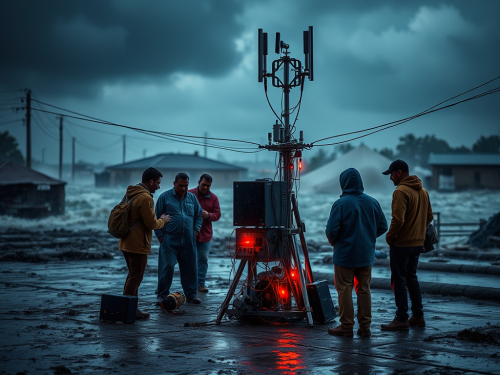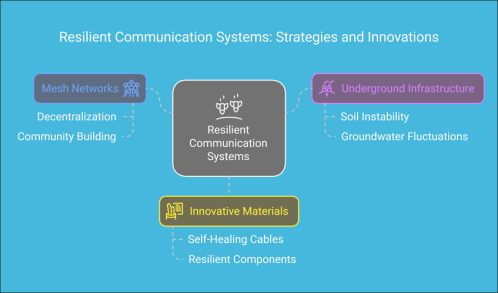Communications Systems Adaptations
As natural disasters intensify, our communication systems require fundamental transformation. There is an urgent need for resilient communication networks that can withstand environmental pressures. #ClimateAdaptation #CommunityResilience
Adapting Communication Systems for an Uncertain Future
The accelerating deterioration of Earth’s biosphere presents unprecedented challenges for maintaining reliable communication networks. These networks are vital not only for coordinating adaptation efforts but for sustaining the social fabric that binds communities together. As extreme weather events intensify and resource constraints grow, our communication infrastructure must evolve while ensuring essential connectivity persists (Rogers 2024).
The Vulnerability of Traditional Infrastructure
Traditional communication infrastructure faces mounting threats from climate-driven disasters. Physical damage to telephone and internet cable networks from flooding, high winds, and temperature extremes is becoming more common (Bartos and Chester 2015). This vulnerability demands innovative approaches to infrastructure design and management.
Innovative Solutions
One promising direction involves the development of mesh networks – decentralized systems that maintain connectivity even when individual nodes fail. The Commotion Wireless project demonstrates how communities can build resilient local networks with limited resources (Rey-Moreno et al. 2017). These distributed architectures prove especially valuable when centralized infrastructure succumbs to environmental stresses.
Underground infrastructure is gaining importance as above-ground systems face increasing challenges. However, even buried infrastructure must contend with soil instability, groundwater fluctuations, and temperature extremes. Recent innovations in materials science, including self-healing cables and resilient components, offer potential solutions (Zhang et al. 2019).
Emergency Communication and Low-Tech Backups
As environmental disruptions become more frequent, robust emergency communication capabilities become critical. Software-defined radio systems provide flexible emergency communications with minimal infrastructure requirements. The Amateur Radio Emergency Service exemplifies the effectiveness of volunteer-based networks during emergencies (ARRL 2022). These systems have repeatedly proven their worth during natural disasters when conventional networks fail.
Most importantly, low-tech backup systems gain value as complex infrastructure faces disruption. Shortwave and packet radio networks offer crucial redundancy when other systems fail. Communities that establish low-tech alternatives demonstrate greater resilience during infrastructure breakdowns (Thompson et al. 2020). This redundancy principle extends to power systems, where distributed renewable energy sources and advanced storage systems support critical communication nodes (Brown et al. 2020).
The Importance of Governance
The challenge extends beyond physical infrastructure to the governance frameworks that guide system development and operation. The International Telecommunication Union has developed comprehensive guidelines for climate-resilient infrastructure (ITU 2023). However, implementing these guidelines faces significant obstacles due to resource constraints and competing priorities.
Real-World Example
The community of Cordova, Alaska, has implemented a microgrid powered by renewable energy sources, coupled with a satellite-based communication system. This has allowed them to maintain communication and power during severe storms that have crippled other coastal communities. This demonstrates the effectiveness of combining innovative technologies with local resources to build resilience.
The Role of Individuals
Beyond government and organizational efforts, individual citizens can play a crucial role. Learning basic first aid, participating in community emergency response teams, and even having a hand-crank radio can contribute to overall community resilience.
Next
Successful adaptation requires a multi-layered approach combining robust physical infrastructure, distributed networks, and strong governance frameworks. We must embrace both technological innovation and proven low-tech solutions while fostering community-based resilience. The stakes couldn’t be higher – our ability to maintain communication systems will determine how effectively we can coordinate responses to mounting environmental challenges.
Conclusion
As we navigate this critical transition, every community must assess its communication vulnerabilities and develop appropriate adaptation strategies. The future may be uncertain, but our response doesn’t have to be. Through thoughtful planning and implementation of resilient communication systems, we can maintain the connections vital for human survival and adaptation in an increasingly unstable world.
References:
ARRL. 2022. Amateur Radio Emergency Service manual. American Radio Relay League, Newington.
Bartos M, Chester M. 2015. Impacts of climate change on electric power supply in the Western United States. Nature Climate Change 5: 748-752.
Brown T, et al. 2020. Response to ‘Burden of proof: A comprehensive review of the feasibility of 100% renewable-electricity systems’. Renewable and Sustainable Energy Reviews 128: 109917.
ITU. 2023. Guidelines on climate-resilient network infrastructure. International Telecommunication Union, Geneva.
Rey-Moreno C, et al. 2017. A telemedicine WiFi network optimized for long distances in the Amazonian jungle of Peru. International Conference on Wireless Technologies for Humanitarian Relief.
Rogers G. 2024. Silent Earth: Adaptations for Life in a Devastated Biosphere. Coldwater Press, Prescott. 333 p.
Thompson A, et al. 2020. Emergency communications during natural disasters: The role of amateur radio in disaster response. Journal of Emergency Management 18: 523-532.
Zhang S, et al. 2019. Nanomaterial-enabled self-healing cables for extreme environments. Advanced Materials 31: 1903875.
Latest Posts
- Communications Systems Adaptations
- AI Comparison
- Comments on the State of the World
- The Town Manager, a Climate-Change Adaptation Novel
- Silent Earth Review
#climate #ClimateChange #ClimateAdaptation #CommunityResilience #DisasterPreparedness #EmergencyCommunications #environment #InfrastructureAdaptation #news #ResilientNetworks #sustainability


